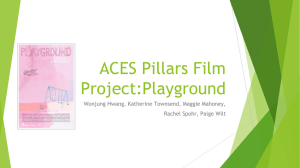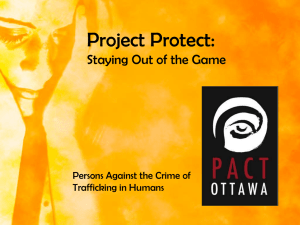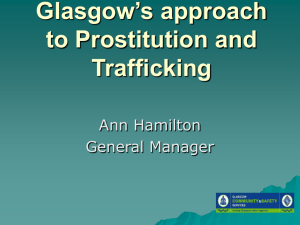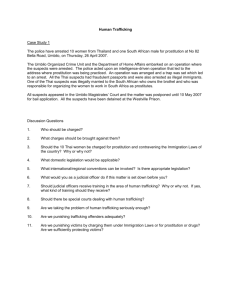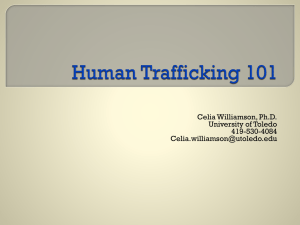Marginalization & Disenfranchisement
advertisement
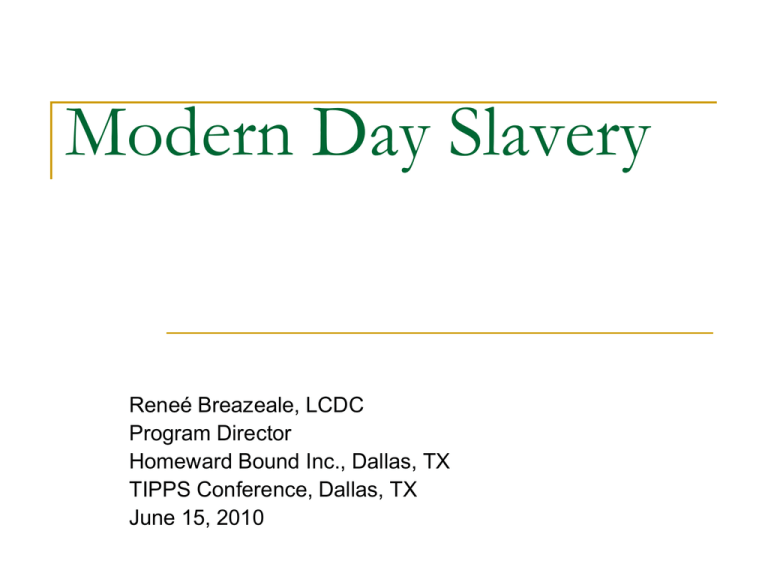
Modern Day Slavery Reneé Breazeale, LCDC Program Director Homeward Bound Inc., Dallas, TX TIPPS Conference, Dallas, TX June 15, 2010 Sex Trade Prostitution Fantasy Operatives Escorts Exotic Dancing Strip Clubs Internet Pornography sites Chat rooms Clandestine sites/rooms/forums Craig’s list Pornography Print Audio/Visual Telephone sex lines Sex Tourism Human Trafficking and Prostitution by Melissa Farley, Ph.D. “According to U.N. estimates, approximately 2.5 million people are being trafficked around the world at any given time, 80% of them women and children. Conservative estimates suggest that the sex industry generates some $32 billion annually. However, estimates of income generated from prostitution in one city, Las Vegas, are as high as $5 billion. Today, sex trafficking is a high-tech, globalized, electronic market, and predators are involved at all levels, using the same methods to control prostituted women that batterers use against their victims: minimization and denial of physical violence, economic exploitation, social isolation, verbal abuse, threats and intimidation, physical violence, sexual assault, and captivity. Despite the illogical attempt of some to distinguish prostitution from trafficking, trafficking is simply the global form of prostitution. Sex trafficking may occur within or across international borders, thus women may be either domestically or internationally trafficked or both. Young women are trafficked for sexual use from the countryside to the city, from one part of town to another, and across international borders to wherever there are men who will buy them.” (published by Psychologists for Social Responsibility psysr.org/issues/trafficking/farley.php; also available via http://www.prostitutionresearch.com/) Human Trafficking Domestic victims of trafficking are those who are trafficked within the United States and are either U.S. citizens or lawful permanent residents. ( http://www.acf.hhs.gov/trafficking/SPOGReport-Final9-5-07.pdf) International victims of trafficking are those who are trafficked into the United States from other countries. ( http://www.acf.hhs.gov/trafficking/SPOGReport-Final9-507.pdf) Victims either do not consent to their situations, or if they initially consent, that consent is rendered meaningless by the actions of the traffickers. Ongoing exploitation of victims to generate illicit profits for the traffickers. Trafficking need not entail the physical movement of a person (but must entail the exploitation of the person for labor or commercial sex) (http://www.acf.hhs.gov/trafficking/index.html) Different than smuggling which involves consent Overview of Human Trafficking Issue Human trafficking is a form of modern-day slavery. Victims of human trafficking are young children, teenagers, men and women. Victims of human trafficking are subjected to force, fraud, or coercion, for the purpose of sexual exploitation or forced labor. After drug dealing, trafficking of humans is tied with arms dealing as the second largest criminal industry in the world, and is the fastest growing. Many victims of human trafficking are forced to work in prostitution or the sex entertainment industry. But trafficking also occurs in forms of labor exploitation, such as domestic servitude, restaurant work, janitorial work, sweatshop factory work and migrant agricultural work. Overview of Human Trafficking Issue Traffickers use various techniques to instill fear in victims and to keep them enslaved. Some traffickers keep their victims under lock and key. However, the more frequent practice is to use less obvious techniques including: Debt bondage - financial obligations, honor-bound to satisfy debt Isolation from the public - limiting contact with outsiders and making sure that any contact is monitored or superficial in nature Isolation from family members and members of their ethnic and religious community Confiscation of passports, visas and/or identification documents Use or threat of violence toward victims and/or families of victims The threat of shaming victims by exposing circumstances to family Telling victims they will be imprisoned or deported for immigration violations if they contact authorities Control of the victims' money, e.g., holding their money for "safe-keeping” In October 2000, the Trafficking Victims Protection Act of 2000 (TVPA) made human trafficking a Federal crime. It was enacted to prevent human trafficking overseas, to protect victims and help them rebuild their lives in the U.S., and to prosecute traffickers of humans under Federal penalties. Prior to 2000, no comprehensive Federal law existed to protect victims of trafficking or to prosecute their traffickers. Prostitution Defined as “Prostitution is the act or practice of being available for sexual services with another person in return for payment. Persons who execute such activity are called prostitutes. Prostitution is one of the branches of the sex industry. Estimates place the annual revenue generated from the global prostitution industry to be over $100 billion.” http://www.havocscope.com/blackmarket/prostitution/ Spectrum of behaviors Usually not a single occurrence It is a behavior NOT an identity Prostitution As stated by one of the peer advocates working with the New Life Opportunities Project: “It is what we DO not WHO we are” New Life Opportunities (NLO) Prostitution Diversion Initiative (PDI) Dallas Police Department lead initiative – only one of its kind in Nation 45+ Social Service Providers engaged University of North Texas – Dept of Epidemiology – lead research and manage outcome data Volunteer driven effort First operation in October 2007 – planning started in May 2007 One night month – first Wednesday Staging area located at I-20 & Lancaster Rd to target 5 truck stops in area Vice and Patrol officers involved November 2009 added Bill J. Priest Institute as alternative site – located downtown on Corinth NLO & PDI (cont) Oct ’08 – Sept ’09 Annual Report: Summary of Findings Demographics Ages of participants at contact ranged from 17-63 years old, with an average age of 37 years Eighty percent of participants were African American Majority contacted were females (99%) Nearly half had less than a high school education Fifty nine percent of those assessed have children Mode of Entry to PDI One person voluntarily walked on-site for services and/or treatment Seventy one additional persons entered the New Life Program outside the night of the PDI Physical Health Problems Of the 182 tested, over half of participants (56%) tested positive for a STD 20 new cases of syphilis and 2 new HIV cases were identified Twenty-one percent of participants reported high blood pressure of which 77% had been treated Other chronic conditions reported included asthma, sickle cell anemia, diabetes, seizures, congestive heart failure, cancer, and chronic back pain Unusual presentations encountered included blindness, deafness, and an intact tracheotomy tube NLO & PDI (cont) Oct ’08 – Sept ’09 Annual Report: Summary of Findings Mental Health Disorders Fifty four percent of participants self-reported having a mental health condition Of these, over half (60%) reported having more than one mental health condition On average, nearly three quarters of participants report receiving treatment for their mental health condition Nearly one third of participants reported major depression or bipolar disorder, respectively Sixteen percent of participants reported having schizophrenia Thirty seven participants have attempted suicide; 59% of whom received medical care Eighty five percent of participants were diagnosed on Axis I (DSM criteria) Nearly two thirds of participants received diagnoses on multiple axes (DSM criteria) Substance Abuse Ninety seven percent of participants reported using drugs and alcohol Nearly half of self-reported drug users admitted to using more than one drug Seventy two percent stated they had tried to quit drugs and/or alcohol The majority stated they used treatment programs to try to quit NLO & PDI (cont) Oct ’08 – Sept ’09 Annual Report: Summary of Findings Outcomes Sixty one percent (n=121) of contacts wanted to go into treatment Eighty six of the 198 contacts (43%) were eligible for immediate diversion to treatment services Nearly half of those eligible opted to enter the PDI New Life treatment program Eighteen (33%) completed the initial phase of treatment, continue to use services, and have not subsequently re-offended in Dallas County 73% using alternative entry completed the initial treatment program, 77% not subsequently re-offending in Dallas County Twenty five participants were repeaters to the PDI in the second year A 38.7% decrease in crime in beats where the truck stops are located *basic demographics were completed for all 198 adult prostitutes contacted. However, only 188 (94%) opted or were mentally able to complete triage assessment NLO & PDI Aggregate Data October 2007 – September 2009 (2 yrs) TOTAL CONTACTS = 375 **Subsequent data refer to 371 adult prostitutes contacted (3 pimps and 1 juvenile not included) AGE Average: 36 (range = 17-63) RACE Black = 274 (74%) White = 81 (22%) Hispanic / Latino = 14 (4%) American Indian = 1 (<1%) Asian = 1 (<1%) SEX Female = 356 (96%) Male = 15 (4%) REPEATERS TO PDI Yes = 47 MODE OF ENTRY Arrest = 344 (93%) Patrol = 178 Vice = 166 Walk on = 27 (7%) Alternative entry (2nd year only – not inclusive of total 375) = 71 NLO & PDI (cont) Aggregate Data October 2007 – September 2009 (2 yrs) ARREST CLASSIFICATION MC = 131 MB = 63 MA = 62 SJ = 44 Misdemeanor and Felony Warrants = 24 No citations issued (earlier initiatives) = 48 (not mutually exclusive) ELIGIBILITY FOR IMMEDIATE DIVERSION Eligible for immediate diversion = 178 (48%) FINAL DISPOSITION Treatment = 106 (29%) Homeward Bound = 51 Nexus = 41 Others* = 14 Jail = 182 (49%) Declined Treatment / Citation= 82 (20%) Missing = 1 (<1%) 60% of those eligible for treatment, opted to enter treatment 23 of the 92 (25%) at Homeward Bound or Nexus completed initial treatment program RE-ARRESTS After contact, 60% (n=186) have not re-offended within Dallas County NLO & PDI (cont) Aggregate Data October 2007 – September 2009 (2 yrs) DATA 2007-2009 Remaining data inclusive of adult prostitutes completing assessment (n=269) OTHER DEMOGRAPHICS Parous (62%) High school graduate or higher education (49%) PHYSICAL HEALTH CONDITIONS SELF-REPORTED Asthma High Blood Pressure Seizures Others: diabetes, cancer, anemia, lupus, arthritis, hypoglycemia, cirrhosis, COPD, fractures, and chemical burns 54% tested positive for STD 246 were presumptively treated MENTAL HEALTH CONDITIONS SELF-REPORTED 54% self-reported having a mental condition Over half of these reported having more than one 30% major depression 29% bipolar 19% suicide attempt 16% schizophrenia SUBSTANCE USE 97% self-report using abusing drugs or alcohol SUCCESSES 15 of the 23 (65%) treatment completers remain abstinent and in supportive services with no subsequent re-offenses in Dallas County Adjunct developments to PDI/NLO ID cards for NLO women Collaboration with Dallas County Community College District for educational support Coordination between Dallas County Sheriff’s Department and Dallas Police Department DNA database for post-mortem identification National Conference on Prostitution – 2nd annual scheduled for November 2010 – 1st had 200 attendees from all over US & Canada “John School” for solicitors of prostitution Salvation Army hosts a family support group for friends & family of persons involved in the sex trade Other identified issues Trauma Typically early on-set Multiple forms of trauma Multiple perpetrators Developmental issues Attachment issues Disassociation Physical Emotional Marginalization & Disenfranchisement Marginalization: to relegate to an unimportant or powerless position within a society or group Disenfranchisement: : to deprive of a franchise, of a legal right, or of some privilege or immunity; i.e. to deprive of the right to vote Marginalization & Disenfranchisement By-products: Isolation Loss of social skills Social behaviors compromised or lost Social norms skewed Loss of communication skills Geographic Emotional Inability to identify and/or verbalize needs appropriately Survival functioning Focus on only those things necessary to survive (food, shelter, clothing) Trauma & Substance Abuse Of clients in substance abuse treatment, 12-34% have current PTSD. For women, rates are 3359% By gender: for women, typically a history of sexual or physical childhood trauma; for men combat or crime Drug choice: No one drug of choice, but PTSD associated with more severe drugs, i.e. cocaine, opiods; “self-medication” in 2/3rds of cases, i.e. PTSD first then substance abuse Source: Seeking Safety, Dr. Lisa Najavits Trauma & Substance Abuse – Treatment Issues Other life problems are common, e.g. other Axis I disorders, personality disorders, interpersonal & medical problems, inpatient admissions, low compliance with aftercare, homelessness, domestic violence PTSD does not go away with abstinence from substances; and PTSD symptoms are widely reported to worsen with initial abstinence Separate treatment systems create specific difficulties with these clients Fragile treatment alliances and multiple crises are common Treatments helpful for either disorder alone may be problematic for someone with both disorders (e.g. exposure therapy, twelve-step groups, use of benzos); also, some messages in substance abuse treatment may be problematic, “hitting bottom” “powerlessness” “confrontation” (Najavits, L. (2001). Seeking Safety. The Guildford Press.) A snapshot of NLO women at Homeward Bound Issue Yes No unknown Co-morbidity 25 4 Axis III complications Prior treatment for CD issues Prior treatment for MH issues 16 19 22 15 12 9 Prior treatment for emotional trauma 12 19 Hx of suicidal/homocidal ideation/attempt 15 16 Hx Hx Hx Hx Hx Hx 8 2 2 22 14 22 23 29 29 9 17 9 of of of of of of self-mutilation learning issues, i.e. disability ADHD dx incarceration homelessness domestic violence Hx of sexual abuse 11 20 Hx Hx Hx Hx 10 23 4 4 11 8 27 27 of of of of sexual assault pregnancies abortions miscarriage 31 respondents over 55 day period - March - May 2010 AGE RANGE = 19 - 60 y/o avg. age =35.9 Ethnic representation: 18 White 11 African American 1 Hispanic 1 Asian Orientation: 29 heterosexual 1 Bisexual 1 Transgender Add'l information 2 colon cancer, HIV, ovarian cysts, HTN, Hep C, Cirrhosis, kidney probs rape, giving child up for adoption, APS case, incest, death of mother @ clt's age 4, domestic violence hanging, stabbing self, OD, earliest reported attempt @ age 12 cutting, burning, scratching w/sharp object special education reported perpetrators: mother's boyfriend, mother, father, brother, gang members/family friends, neighbor, cousin, uncle, significant other; earliest age of onset: infant perpetrators: friend's brother, date, "john"
